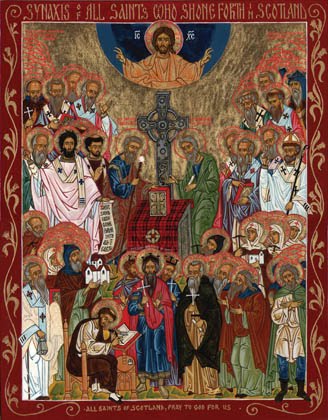The Beginning of the End
Now the Celtic Churches had had little to do with Rome – not out of antipathy, but because of distance and, especially, a long period in the fifth and sixth centuries during which the Celts had been cut off from the Church on the continent by the pagan invasions. In any case, Celtic Christianity owed as much to Eastern, Orthodox Christianity as it did to Rome.[1] By contrast, after the English were converted to Orthodoxy in the seventh century, they became perhaps the most fervent “Romanists” of all the peoples of Western Europe.
This devotion sprang from the fact that it was to Rome, and specifically to Pope St. Gregory the Great and his disciples, that the Angles, Saxons and Jutes of Southern England owed their conversion to the Faith in the late sixth and early seventh centuries. From that time English men and women of all classes and conditions poured across the Channel in a well-beaten path to the tombs of the Apostles in Rome[2], and a whole quarter of the city was called “Il Borgo Saxono” because of the large number of English pilgrims it accomodated.[3] English missionaries such as St. Boniface of Germany carried out their work as the legates of the Roman Popes. And the voluntary tax known as “Peter’s Pence” which the English offered to the Roman see was paid even in the difficult times of the Viking invasions, when it was the English themselves who were in need of alms.
However, the “Romanity” to which the English were so devoted was not the Franco-Latin, Roman Catholicism of the later Middle Ages. Rather, it was the Greco-Roman Romanitas or Rwmeiosunh of Orthodox Catholicism. And the spiritual and political capital of Romanitas until the middle of the fifteenth century was not Old Rome in Italy, but the New Rome of Constantinople.[4] Thus when King Ethelbert of Kent was baptized by St. Augustine in 597, “he had entered,” as Fr. Andrew Phillips writes, “‘Romanitas’, Romanity, the universe of Roman Christendom, becoming one of those numerous kings who owed allegiance, albeit formal, to the Emperor in New Rome…”[5] Indeed, as late as the tenth century the cultural links between England and Constantinople remained strong.
We may tentatively point to the murder of King Edward the Martyr in 979 as the beginning of the end of Orthodox England. “No worse deed for the English was ever done that this,” said the Anglo-Saxon Chronicle[6]. And while it was said that there was “great rejoicing” at the coronation of St. Edward’s half-brother, Ethelred “the Unready”, St. Dunstan, archbishop of Canterbury, sorrowfully prophesied great woes for the nation in the coming reign.[7]
He was right; for not only were the English successively defeated by Danish pagan invaders and forced to pay ever larger sums in “Danegeld”, but the king himself, betrayed by his leading men and weighed down by his own personal failures, was forced to flee abroad in 1013. The next year he was recalled by the English leaders, both spiritual and lay, who declared that “no lord was dearer to them than their rightful lord, if only he would govern his kingdom more justly than he had done in the past.” [8]
But the revival was illusory; further defeats followed, and in 1017, after the deaths both of King Ethelred and of his son Edmund Ironside, the Danish Canute was made king of all the English. Canute converted to the faith of his new Christian subjects; and the period of the Danish kings (1017-1042) created less of a disruption in the nation’s spiritual life than might have been expected. Nevertheless, it must have seemed that God’s mercy had at last returned to His people when, in 1043, the Old English dynasty of Alfred the Great was restored in the person of King Ethelred’s son Edward, known to later generations as “the Confessor”.
It is with the life of King Edward that our narrative begins.
However, in order to understand the world of King Edward it is necessary briefly to review cultural and ecclesiastical developments on the continent of Europe, which began to influence England precisely in his reign. These included the rise of the heretical papacy and the growth of feudalism.
THE FALL OF ORTHODOX ENGLAND- Vladimir Moss
Vladimir Moss


No comments:
Post a Comment